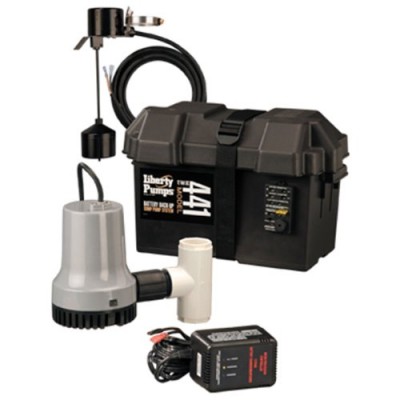Pond Pumps Canada is part of the Amazon Affiliate Network. We may receive payment for items purchased through the Amazon website.
Liberty Pumps 441 is a battery back-up sump pump system with alarm. Operating from the power of a marine-grade deep-cycle 12V battery. It is designed to temporarily back up a primary sump pump during a power outage or other problem which prevents normal operation of the primary pump. The Liberty 441 is not intended to be used as the main sump water removal pump.Advanced Charging System of the Liberty Pumps 441 outperforms "trickle" chargers with a 5-stage charging process. The system tests the battery and maintains a maximum charge without running the battery down or selfdischarging. A sophisticated charging algorithm continuously tests the charging process from start to finish.This Battery Back-up Sump Pump System features time dependent charging with built-in 150-hour safety timer. If the safety timer "times-out," the red "Fault" L.E.D. is displayed and charging is discontinued to protect equipment from "run-away" battery under charge.NOTE Frequency of pump cycle, length of running time and pumping head will vary the lifetime of battery operation. Under a continuous-run situation the battery will last up to 4 hours and up to 30 hours in intermittent operation.Audible alarm and light advises of emergency pump operation. The alarm, located in the junction box, automatically sounds when the system runs if the alarm is in the "Enable" position. The alarm is silenced when the alarm switch is in the "Disable" position.There are two ways to install the Liberty 441 Battery Back-up Sump Pump. See included documentation.IMPORTANTDo not use this system to pump flammable liquids or chemicals.Pump clear water only with this pump.Keep battery charger dry and protected from damage.Automobile batteries are not designed for this type of application and may be substituted temporarily in an emergency. The Automobile battery will be quickly ruined by the repeated charge/discharge cycling. Use of an automobile battery will significantly reduce system total performance.
- High output 12 volt submersible pump
- Automatic, mercury-free switch - Control panel
- Battery box and strap (battery not included)
- Tee, check valve and bushings for 1-1/2" or 1-1/4" connections
Liberty Pumps 441 Battery Back-Up Emergency Sump Pump System
- Brand: Liberty Pumps
- Product Code: 441
- Availability: In Stock
Related Products
Liberty Pumps 257 1/3-Horse Power 1-1/2-Inch Discharge 250-Series Cast Iron Automatic Submersible Sump/Effluent Pump with VMF Switch
Liberty Pumps 257 1/3-Horse Power 1-1/2-Inch Discharge 250-S..
Liberty Pumps 287 1/2-Horse Power 1-1/2-Inch Discharge 280-Series Automatic Submersible Sump Pump with VMF Switch
Pumps up to 67 GPM;Maximum head 37-Foot;Quick-disconnect 10-..
Liberty Pumps 237 1/3-Horse Power 1-1/2-Inch Discharge 230-Series Automatic Submersible Sump Pump with VMF Switch
Liberty Pumps 237 1/3-Horse Power 1-1/2-Inch Discharge 230-S..
Check Valve Quiet CLR1.5 by Brady MfrPartNo 0823-15C
Disposable Ear Plug DispenserBRADY..
Dynamic Head
The effect of the Earths gravity on the "lift" or head pressure is fairly simple; for every vertical foot of distance the pump moves the water you are adding one foot of head pressure so the ratio is a 1:1 ratio. The effects of the friction, caused by water as it travels through your hose or pipes, on the total head pressure is a little more difficult to calculate especially as there are slight variations in pipe friction in different hose materials and the smoothness of the inner bore. Basically. for every ten feet of pipe through which the water has to travel travel horizontally will contribute 1 foot of head height; the ratio of the pipe friction loss is a 10:1 ratio.Plumbing fixtures and bends and corners in your hose also increase the total head you must calculate to ensure the proper final volume from your pump. Every corner with a 90 degree elbow in your plumbing will add 1 foot of head pressure with a 1:1 ratio. 45 degree elbows, tees and even insert couplers can all have an impact on the final flow.
If you install a pump 40 feet away from the top of your waterfall which is 6 feet above the pump and the tubing is a single run of 40 feet horizontally then you add 4 feet of head for the tubing length (the 10:1 ratio) to the 6 foot differnetial between the pump location and the final height of the waterfall so your final total dynamic head calculation would be 10 feet. This means your final volume of water flow in this water feature or application would be the volume of flow on the performance curve that equaled the gallons per hour at 16 feet. This volume will certainly be much less than the initial volume the pump can move at an open flow or a zero head.
If in the above example your 40 feet of horizontal tubing run also required 3 elbows of 90 degrees then an additional 3 feet of theoretical head would be added and your final flow result would be at 19 feet on the performance curve of the pump. In this example you would want to choose a pump that has the desired GPH rating at 9 feet of head pressure. Tubing size is also an important factor in accounting for head pressure loss, in general you should never reduce the diameter of the tubing below what the output size of the pump is, this will drastically increase head pressure, and reduce pump performance. For maximum pump performance, using the largest tubing that is practical is the best choice. A best practice is to use a hose with an inner diameter that is the same as your pumps outlet fitting.

